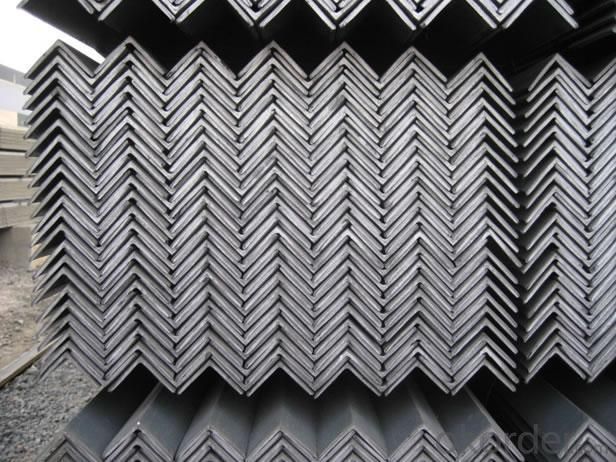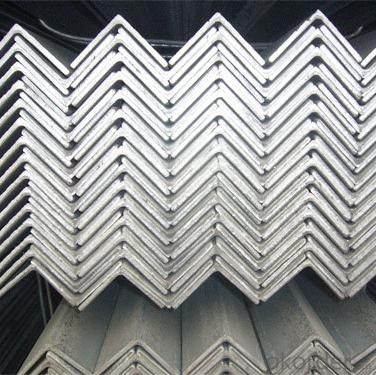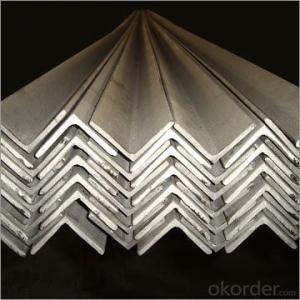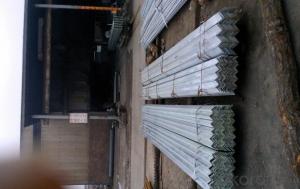EN10025 Equal steel angle for construction
- Loading Port:
- Tianjin
- Payment Terms:
- TT or LC
- Min Order Qty:
- 25 m.t.
- Supply Capability:
- 100000 m.t./month
OKorder Service Pledge
OKorder Financial Service
You Might Also Like
Product Description:
OKorder is offering EN10025 Equal steel angle for construction at great prices with worldwide shipping. Our supplier is a world-class manufacturer of steel, with our products utilized the world over. OKorder annually supplies products to European, North American and Asian markets. We provide quotations within 24 hours of receiving an inquiry and guarantee competitive prices.
Product Applications:
EN10025 Equal steel angle are ideal for structural applications and are widely used in the construction of buildings and bridges, and the manufacturing, petrochemical, and transportation industries.
Product Advantages:
OKorder's Equal steel angle are durable, strong, and resist corrosion.
Main Product Features:
· Premium quality
· Prompt delivery & seaworthy packing (30 days after receiving deposit)
· Corrosion resistance
· Can be recycled and reused
· Mill test certification
· Professional Service
· Competitive pricing
Product Specifications:
Specifications of Equal Angle Steel
1.Standards:GB
2.Length:6m,9m,12m
3.Material:GBQ235,Q345 or Equivalent
Usage & Applications of Equal Anlge Steel
Trusses;
Transmission towers;
Telecommunication towers;
Bracing for general structures;
Stiffeners in structural use.
Packaging & Delivery of Equal Angle Steel
1. Transportation: the goods are delivered by truck from mill to loading port, the maximum quantity can be loaded is around 40MTs by each truck. If the order quantity cannot reach the full truck loaded, the transportation cost per ton will be little higher than full load.
2. With bundles and load in 20 feet/40 feet container, or by bulk cargo, also we could do as customer's request.
3. Marks:
Color mark: There will be color marking on both end of the bundle for the cargo delivered by bulk vessel. That makes it easily to distinguish at the destination port.
Tag mark: There will be tag mark tied up on the bundles. The information usually including supplier logo and name, product name, made in China, shipping marks and other information request by the customer.
If loading by container the marking is not needed, but we will prepare it as customer request.
*If you would like to get our price, please inform us the size, standard/material and quantity. Thank you very much for your attention.
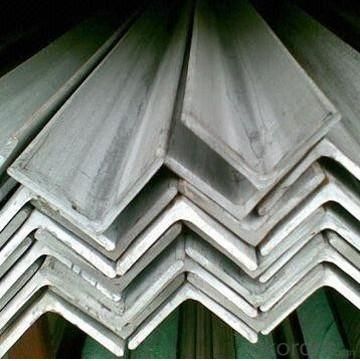
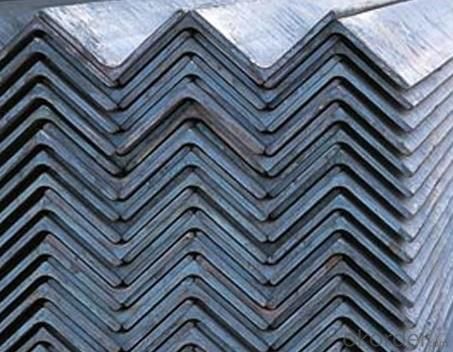
FAQ:
Q1: Why buy Materials & Equipment from OKorder.com?
A1: All products offered byOKorder.com are carefully selected from China's most reliable manufacturing enterprises. Through its ISO certifications, OKorder.com adheres to the highest standards and a commitment to supply chain safety and customer satisfaction.
Q2: What makes stainless steel stainless?
A2: Stainless steel must contain at least 10.5 % chromium. It is this element that reacts with the oxygen in the air to form a complex chrome-oxide surface layer that is invisible but strong enough to prevent further oxygen from "staining" (rusting) the surface. Higher levels of chromium and the addition of other alloying elements such as nickel and molybdenum enhance this surface layer and improve the corrosion resistance of the stainless material.
- Q: Can steel angles be used in the construction of airport terminals?
- Yes, steel angles can be used in the construction of airport terminals. Steel angles are commonly used in construction for their strength, durability, and versatility. They are often used in framing, supports, and bracing structures. In airport terminal construction, steel angles can be used for various applications such as supporting structural beams, framing windows and doors, creating partitions, and reinforcing walls and columns. Additionally, steel angles can be easily welded, bolted, or fastened together, allowing for efficient construction and flexibility in design. Overall, steel angles are a reliable and cost-effective choice for the construction of airport terminals.
- Q: Can steel angles be used in solar panel installations?
- Solar panel installations can indeed incorporate steel angles. When it comes to diverse construction projects like solar panel installations, steel angles are often employed as a fundamental support. They play a crucial role in establishing stability and fortitude within the solar panel system, guaranteeing a secure attachment to either the ground or the mounting structure. The durability of steel angles, combined with their resistance to environmental elements, renders them highly suitable for outdoor applications. Moreover, the adaptability and ease of fabrication of steel angles allow for customization that caters to the specific needs of the solar panel installation, thereby offering design flexibility and versatility.
- Q: Can steel angles be used for decorative purposes?
- Yes, steel angles can definitely be used for decorative purposes. They can be shaped and designed in various ways to add a modern and industrial touch to interior or exterior spaces. Steel angles can be used as decorative accents, such as in furniture design, architectural details, or even as standalone decorative pieces. Their durability and versatility make them an excellent choice for adding a unique and stylish element to any space.
- Q: Can steel angles be easily cut to size?
- Certainly! Cutting steel angles to size is a breeze. These angles are widely employed in construction and fabrication endeavors, and they come in a range of lengths and sizes. Achieving the desired length is a simple task with tools like a hacksaw, angle grinder, or plasma cutter. Nevertheless, the ease of cutting steel angles hinges on the steel's thickness and hardness. If the angles are thicker and harder, more potent tools and cutting techniques may be necessary. It's crucial to employ proper safety precautions and tools to guarantee precise and flawless cuts when working with steel angles.
- Q: Can steel angles be used in automotive chassis construction?
- Yes, steel angles can be used in automotive chassis construction. Steel angles are commonly used in the construction of automotive chassis due to their structural strength, durability, and cost-effectiveness. They provide excellent support and stability, making them suitable for various chassis components such as frame rails, cross members, and suspension mounting points. Additionally, steel angles can be easily welded or bolted together, allowing for efficient assembly and customization of automotive chassis structures.
- Q: What are the different standards and specifications for steel angles?
- Steel angles have various standards and specifications that dictate their physical and mechanical properties. Some commonly used standards are as follows: 1. Carbon structural steel angles are covered by ASTM A36/A36M. This standard provides details on the chemical composition, mechanical properties, and other requirements for carbon steel angles. 2. High-strength carbon-manganese steel angles are specified under ASTM A529/A529M. This standard outlines the composition, mechanical properties, and other specifications for these angles. 3. ASTM A572/A572M covers high-strength low-alloy columbium-vanadium structural steel angles. It provides information on the chemical composition, mechanical properties, and other requirements for these angles. 4. High-strength low-alloy structural steel angles with improved atmospheric corrosion resistance are specified in ASTM A588/A588M. This standard details the chemical composition, mechanical properties, and other characteristics for these angles. 5. For use in bridges, carbon and high-strength low-alloy structural steel angles are covered by ASTM A709/A709M. This standard provides information on the chemical composition, mechanical properties, and other specifications for these angles. 6. EN 10056 is a European standard that specifies tolerances on shape, dimensions, and mass of hot-rolled structural steel equal and unequal angles. It also provides information on the mechanical properties and other requirements for these angles. 7. JIS G3192 is a Japanese standard that specifies dimensions, mass, and permissible variations of hot-rolled steel sections, including angles. It outlines the mechanical properties and other specifications for these angles. These examples demonstrate the diversity of standards and specifications for steel angles. It is crucial to refer to the relevant standard for your specific project or application to ensure that the steel angles meet the required criteria.
- Q: Double angle steel rod in the corners of the roof steel why need to set the plate?
- Pad is used to pad something to make it more convenient and comfortable things, commonly used in the examination to avoid paper directly on the table caused by writing difficulties of the board, are usually hard paper. In architecture, a plate member between the upper and lower two upper and lower two purlin Fang or architrave, thickness is usually a fight.
- Q: How do you calculate the critical buckling load for a steel angle?
- In order to determine the critical buckling load for a steel angle, one must take into consideration the properties of the angle section and how it interacts with the applied loads. The critical buckling load refers to the maximum load that the angle section can handle before it buckles or fails in a lateral-torsional manner. The initial step involves calculating the section properties of the steel angle, such as its moment of inertia (I) and section modulus (Z). These properties can be obtained either from standard structural design tables or through mathematical calculations. Subsequently, the effective length factor (K) for the angle section needs to be considered. This factor accounts for the angle's end conditions and how it is restrained against buckling. Different end conditions have varying values for K, which can be determined from design codes or engineering references. Once the section properties and effective length factor have been determined, the critical buckling load can be calculated using Euler's buckling equation: Pcr = (π^2 * E * I) / (K * L^2) Here, Pcr represents the critical buckling load, π is a mathematical constant (approximately 3.14159), E denotes the modulus of elasticity of the steel, I signifies the moment of inertia of the angle section, K represents the effective length factor, and L stands for the unsupported length of the angle section. By substituting the appropriate values for E, I, K, and L into the equation, one can calculate the critical buckling load for the steel angle. It is crucial to note that the critical buckling load is a theoretical value and should be compared to the actual applied loads to ensure the safety of the angle section under the given conditions.
- Q: Can steel angles be used as reinforcement in concrete structures?
- Yes, steel angles can be used as reinforcement in concrete structures. Steel angles are often used as L-shaped or angle-shaped bars that are embedded within the concrete to provide additional strength and support to the structure. These angles help to resist tensile forces and prevent cracking or failure of the concrete. They are commonly used in applications such as beams, columns, and walls to enhance the structural integrity and load-bearing capacity of the concrete elements. Additionally, steel angles can be easily welded or bolted together, making them a versatile and cost-effective choice for reinforcement in concrete structures.
- Q: How are steel angles used in framing?
- Steel angles are used in framing for a variety of purposes. One of the primary uses of steel angles in framing is to provide structural support and stability to the framework of a building or structure. These angles are typically used in conjunction with other building materials, such as wood or concrete, to create a sturdy and durable frame. Steel angles are commonly used to create corners in the framing of a building. They are often placed at the intersections of walls and floors to provide reinforcement and prevent the structure from sagging or collapsing. Additionally, steel angles are used to secure and strengthen joints between beams, columns, and other structural elements. In addition to their structural role, steel angles are also utilized for their versatility in framing. They can be easily cut, bent, and welded, allowing for customization and adaptation to various construction needs. Steel angles can be used to create braces, supports, and even decorative elements in the framing of a building. Furthermore, steel angles are known for their high strength and resistance to bending or warping. This makes them ideal for withstanding heavy loads and providing long-lasting support in a framing system. Their durability and reliability make them a preferred choice in many construction projects. Overall, steel angles play a crucial role in framing by providing structural stability, reinforcement, and versatility. Their use in framing ensures the strength and durability of a building or structure, making them an essential component in the construction industry.
Send your message to us
EN10025 Equal steel angle for construction
- Loading Port:
- Tianjin
- Payment Terms:
- TT or LC
- Min Order Qty:
- 25 m.t.
- Supply Capability:
- 100000 m.t./month
OKorder Service Pledge
OKorder Financial Service
Similar products
Hot products
Hot Searches
Related keywords




